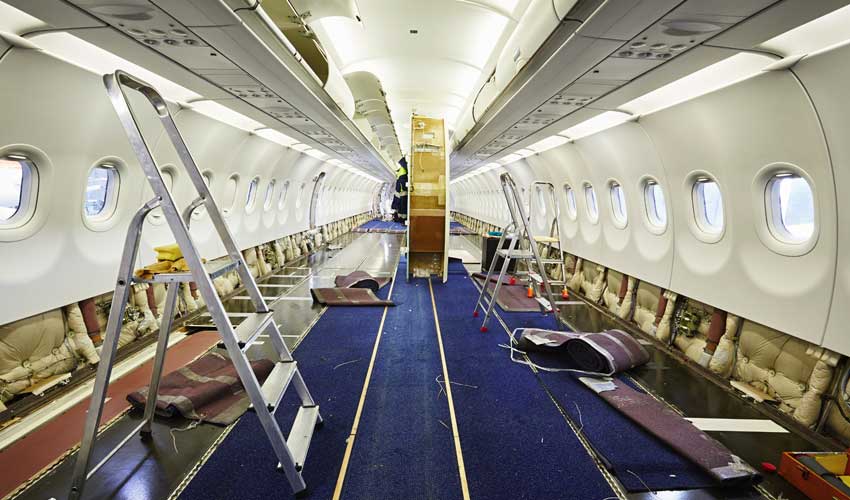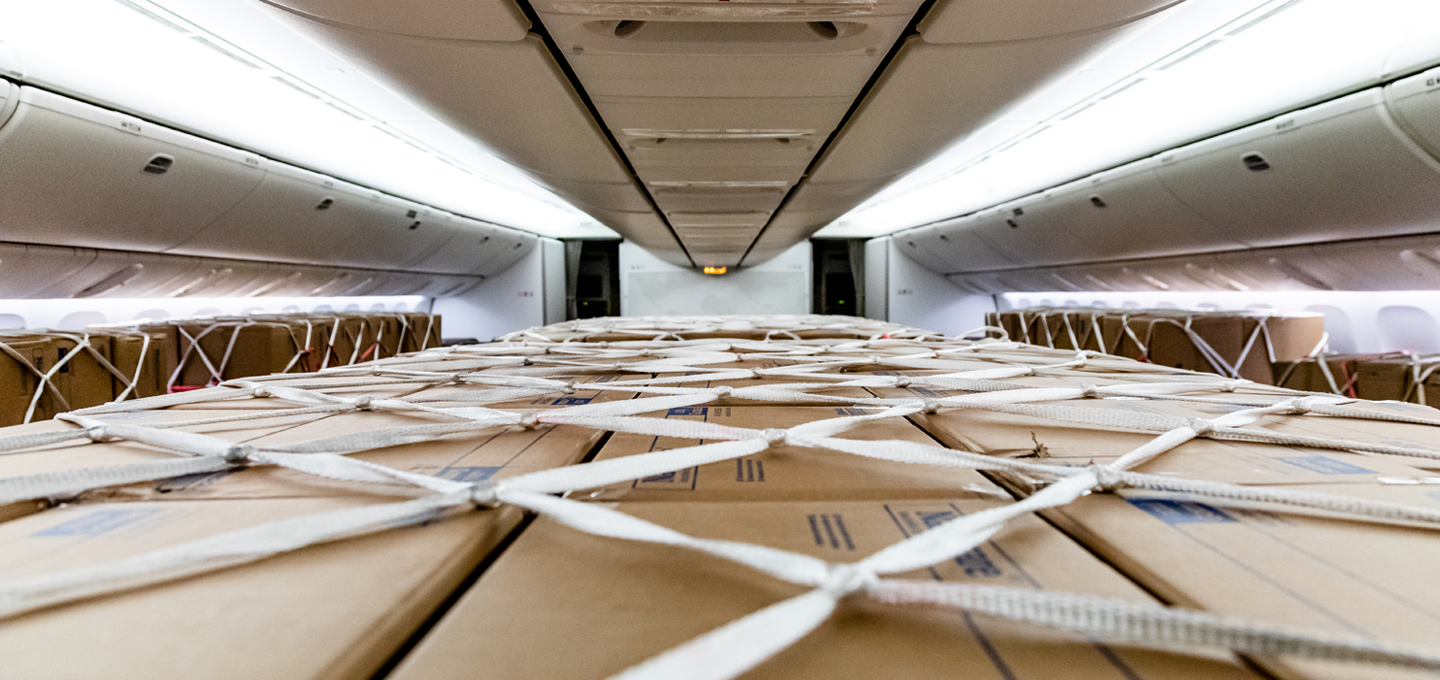In the wake of the coronavirus, airlines have had to think up new ways to face operational disruptions. While very few travelers are still flying, thousands of tons of cargo must be delivered every day. Thanks to dedicated compartments, commercial jets have always played a crucial role in transporting time-sensitive consignment. However, since the pandemic grounded entire fleets, the shortage of airfreight moves has begun to make itself felt.
Only in March, the International Air Transport Association (IATA) registered a nearly 23% decrease in air cargo capacity. To keep supply chains running, carriers are creating so-called “passenger freighter networks”. The challenge here is to maximize the utilization of airplanes that were not conceived to carry shipments up top. Besides the use of regular cargo holds, some operators are taking advantage of the storage area under the seats. Others get one step further, reconfiguring the whole passenger cabin to make way for more boxes.
But, to what extent are airlines allowed to pile up as many items as possible? Which requirements must they fulfill to ensure an optimal passage of goods?
Before carrying cargo on passenger aircraft…
Do: Conduct a safety risk assessment
To achieve expediency in a completely new context, commercial aviation has been forced to reevaluate its processes. Moving freight in so popularly known “ghost flights” are not exempted from risks. A comprehensive assessment of possible hazards shall be performed before planning to make some changes to the airplane´s configuration. How precise the analysis will be, depends on the cooperation between different operational departments.
Some events that can trigger irregularities include:
- Inadequate handling of dangerous goods.
- Failure of bulkheads, floor, and other cargo compartments.
- Liquid leakage affecting aircraft intern systems.
- Loose trolleys or canisters crashing into the cabin.
- Overheating of the galleys´ equipment and the in-flight entertainment system (IFE).
How frequently should the safety risk assessment take place? There is no golden rule for that. Each carrier must adjust and verify that the content of this evaluation is up to date and in compliance with current laws.
Do: Establish control measures to mitigate any associated risks
Once the threats have been identified and evaluated, it comes to the elaboration of a plan to eliminate potential hazards. The definition of control measures will vary depending on how daily operations are conducted, the characteristics of the airplane fleets, and the stand of the resources available. The Safety Alert for Operators (SAFO) recommends keeping these aspects under the radar:
- Determine accurate weight and balance parameters according to the type of cargo and storage location.
- Ensure that storing configuration does not hinder the use of emergency equipment.
- Doublecheck the availability of operational and personal protective gear.
- Strength supervision of loading and unloading sequences to guarantee freight is properly stocked.
- When handling hazardous materials, crew members and ground staff must be aware of safety precautions.
- The access to the cargo deck should be restricted to authorized qualified personnel.
- Set an action plan for potential undeclared dangerous goods that are hidden within the consignment.
- If passenger seats are not removed, verify that the electricity in all the galleys − except the front one − is switched off.
In contrast to the belly hold, modern wide-body jets do not count with dedicated fire suppression systems in the fuselage. For this reason, national regulators are requiring airlines to train cabin crew on how to perform a proper control of the shipment to prevent any eventuality.

Do: Instruct personnel on what are the approved cargo locations
Regulators restrict the stuffing of items within the passenger compartments following a standard classification. To avoid permit restrictions and operating delays, it is crucial to keep the ramp staff updated on these configuration norms. The current general guidance propounds the most adequate locations based on the type of products to be placed. However, some specific requirements can apply depending on the local normative.
The carriage of live animals or substances that pose some risk to health is only allowed in the cargo hold. Necessity goods such as medicines and humanitarian supplies can be distributed among the overhead stowage bins, closets, floor-mounted stowage, and the space under the seats. A special consideration has the transport of mail: It is not advisable to load it in the cabin unless the presence of potential hazards – chemical, electrical − has been discarded.
Good to know >> Consignment can be carried underneath the seats as long as it can be fastened with restraint bars. The mass of each piece should also not trespass the 20 lbs. maximum.
Don’t: Load unverified shipment on to passenger cabin
Due to the diversity of the nature of freight, verifying its content has become of paramount importance. The physical characteristics and chemical composition of certain products require the observation of specific handling protocols to guarantee safe transportation. The highly complex operating environment around airfreight and mail demands a constant evaluation of procedures to enhance security.
In the past, several attempts at concealing dangerous devices in consignments demonstrated that operators must focus on applying more efficient measures. An appropriate screening help to clear suspicious items. But, what happens if usual methods cannot be used due to the objects´ size and volume, or the type of packaging? It is important that stakeholders develop security protocols at different stages of the supply chain. That includes all transit points before reaching the last airport of arrival.
Don’t: Remove seats without authorization
In general, placing pallets directly on the passenger-cargo floor is only allowed with the approval of the jet manufacturer and the respective National Aviation Authority (NAA). Once the permission has been granted, operators must verify by each shipment preparation that:
- The main deck is not full of containers. The equivalent space of one complete road of seats needs to remain free at the forward and the end of the fuselage.
- The floor limits shall not be outstripped in conformity with the aircraft manufacturer manual.
- To restrain items in pallets, TSO certified nets and straps are the most suitable choice due to their deformation resistance.
- The tolerance limits within the cargo center of gravity (CG) can fall is +/- 10% of the tie-down center.
Don’t: Pile up packages on seats heavier than 110 lbs.
Making use of seating rows is restricted for boxes of up to 110 lb. So, can operators ensure that the items are secured safely, without damaging the structure of the seats. Important is here, that the mass of consignment is evenly distributed across the row. It is advisable that the CG of each package is equal or lower than the passenger one as indicated in the envelope drawing of the seat. Otherwise, it could topple if the aircraft experiences turbulence.
How does a proper attachment mechanism look like? Belts or other tie-down help to prevent dislodges during the flight. The number of restraint devices to use will depend on the strength required to keep the products steady. This could be calculated based on the load factor and the box weight. Alternatively, the seat attachment parameter specified in the airplane´s manufacturer Weight and Balance Manual (WBM) serve as a reference.
Summing up: Anything goes in without preparation!
When an airline decides to put its passenger aircraft on service for moving cargo, it must be informed about the regulatory frameworks applicable. These will differ according to the State where the airports of origin and destination are located. A good practice to comply with the norms is to execute extensive item verifications before loading anything in the main deck. Such a measure helps to discard potential unauthorized content. Facilitating regular trainings for ground staff is also essential, so that they can be aware of currently approved shipment configurations. Likewise, they shall be able to discern in which cases a manual handling can apply and when do they need the support of special equipment to avoid direct exposure with certain objects. With a proper planning strategy, carriers will reach more efficiency and make sure, flights depart on time.





0 comments on “Dos and Don’ts For Carrying Cargo On Passenger Aircraft”